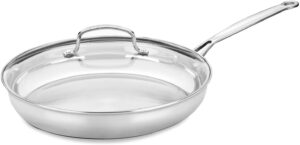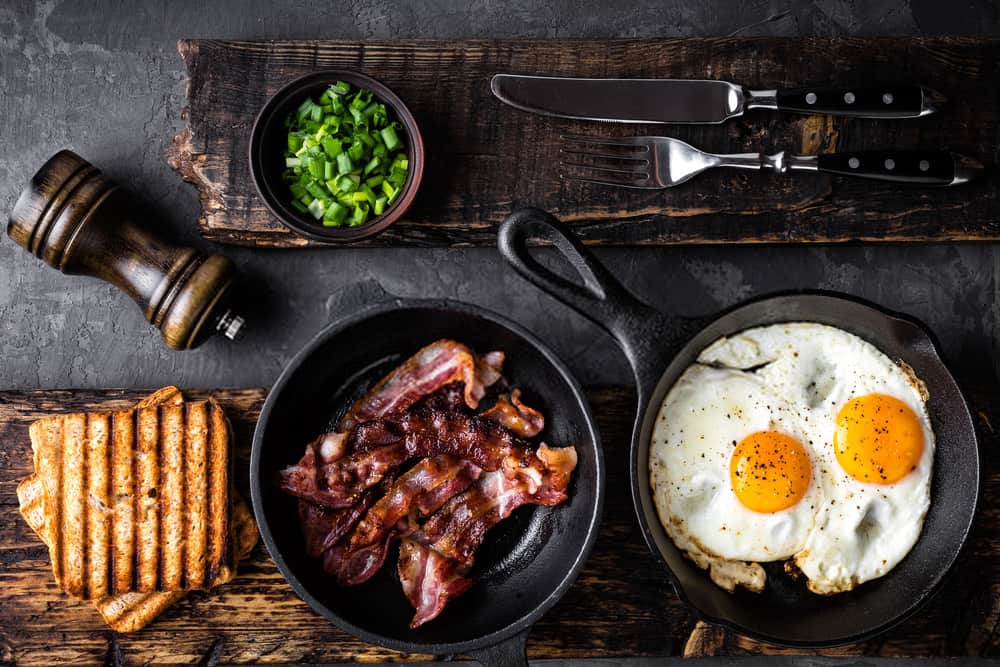How to care for your skillet

There is a lot of conflicting advice out there on how to care for a cast-iron skillet. Some say you should scrub it with soap and water, some say you should only use a wire brush to remove stuck-on bits…but what is the real truth? Unfortunately, the answer isn’t so simple because different skillets will require different treatments.
Every cook needs a good skillet. In the long run, you will find that a quality skillet is well worth the investment. You will get years of use from your skillet if you care for it properly and maintain its nonstick surface by preheating it before cooking with any oil, butter or shortening and only using wooden utensils with a heat-resistant handle. You can also make sure to avoid dishwasher detergent because it removes some of the protective coating on the inside of the pan.
A variety of skillets are available. The most common types are cast iron, copper, glass or stainless steel. Cast iron is the best skillet material because it heats evenly and retains heat well. It also takes a beating, making it perfect for almost any cooking task. It transfers heat slowly to the food being cooked so that it is cooked evenly on the inside as well as on the outside, but it will take longer to reach temperature before you can start cooking with it compared to other options.
Cast iron skillets are heavy and bulky, so they are only a good option if you have a plan for storing them, either with a hanging pot rack or in a cupboard or pantry. Because of this, cast iron skillets come in a number of sizes from small to large.
Copper is second best when it comes to skillet material. Copper is lightweight and conducts heat well when it is new, but when it gets worn over time, it does not conduct heat as well. It also scratches easily. A copper skillet is an investment and will not need to be replaced in the long run, but it can be expensive and is not easy to work with.
What to do when you cook in a cast iron skillet:

- Preheat your skillet with either unsalted butter, shortening or oil. A quick stir about halfway through cooking will help it preheat faster.
- When the skillet is preheated, add oil, butter or shortening to grease the bottom of your skillet. If you are using butter for cooking purposes, make sure that you are purchasing unsalted.
- When the butter or oil is hot on the skillet but remains fluid enough not to stick while you are cooking, place it on the stove over medium heat. Use caution while adding any liquids not to burn it.
- Add items to be cooked to the skillet.
- Cook the food until it is ready to serve or fully cooked through.
What to do when you cook in a copper skillet:
- Preheat your skillet with either unsalted butter, shortening or oil. A quick stir about halfway through cooking will help it preheat faster.
- When the skillet is preheated, add oil, butter or shortening to grease the bottom of your skillet.
- When the butter or oil is hot but remains fluid enough not to stick while you are cooking, add a little water to lubricate it and then into the skillet you will put some oil or a nonstick cooking surface coating.
- When the oil is hot but remains fluid enough not to stick while you are cooking, add some items to be cooked to the skillet.
- Cook the food until it is ready to serve or fully cooked through.
What to do when you cook in a glass skillet:

When using glass for cooking purposes, make sure to handle it with extreme care — there is no nonstick coating on glass and it scratches easily. It is heavy and gets hotter than other skillets, so you will want to use it over a stovetop rather than on the stove top grill.
What you do when you cook in a stainless steel skillet:
This is a great option for those who are more careful about their kitchenware and do not want to deal with the weight of a cast-iron skillet. They have more options, from smaller for individual portions to larger sizes that can be filled with more food at once. Stainless steel skillets are durable but are not made to be left at high heat for long periods of time.
How you care for your skillet:
- To clean a cast-iron skillet, remove it from the stovetop by using an oven mitt or potholder and try to avoid getting burned by the hot handle. If this is not possible, turn the handle so that it is facing down. Wash your skillet with warm water and dish soap if necessary, then hand dry it with a towel. Make sure to dry it thoroughly, then heat it over medium heat for a few minutes. Apply oil or melted butter to the bottom of your skillet.
- To clean a copper-bottomed skillet, remove it from the stovetop by using an oven mitt or potholder and try to avoid getting burned by the hot handle. If this is not possible, turn the handle so that it is facing down. Wash your skillet with warm water and dish soap if necessary, then dry off the inside with a cloth or paper towel. Apply a very thin coat of oil or melted butter to the bottom of your skillet, then cook it over medium heat for a few minutes.
- To clean a glass-bottomed skillet, remove it from the stovetop by using an oven mitt or potholder and try to avoid getting burned by the hot handle. If this is not possible, turn the handle so that it is facing down. Wash your skillet with warm water and dish soap if necessary and dry off the inside with a cloth or paper towel. Apply a very thin coat of oil or melted butter to the bottom of your skillet, then cook it over medium heat for a few minutes.
- To clean a stainless steel skillet, make sure to use a towel and avoid getting burned by the hot handle. Wipe off any stickiness with a damp cloth or paper towel then dry thoroughly with a cloth or paper towel. Apply a very thin coat of oil or melted butter to the bottom of your skillet, then cook it over medium heat for a few minutes.
- Skillet care is important to keep your skillet looking good and performing well for years to come.
If you want to purchase new skillets ,here are some of our recommendations;
The Radiance hard anodized nonstick frying pan set comes in 8.5-in, 10-in, and 12.25-in sizes with some of the best features one would want for frying pans.
Quality materials make it a durable choice even for regular use while cookware handles are oven safe to 425°F/220°C. The surface is PFOA free and does not contain any heavy metals while the gray cookware color is fashionable on its own or goes well with most kitchen designs.
This Seasoned Cast Iron 3 skillet bundle includes 12 inches, 10.25 inches, and 8 inch cast iron frying pans in one set.
The pans are color seasoned in the interior. A black seasoning remains on exterior of pans to give them an aged appearance. The handles are smooth and comfortable with solid wood handles that have been strengthened with brass rivets.
This set contains 3 pans of each size in one set, so you can choose which size you would like when ordering this item.

This is the perfect camping gear item – a great gift for campers and outdoorsmen. The silicone handle cover may be removed if desired, which gives you the option of using the pan without the handle.
We hope these tips will help you make the best use of your cast iron skillet in order to avoid rust and also show you a short list of things that I have found helpful when cooking with a skillet, as well as a bit of information on what exactly is going on with your cookware and why it’s important.
Thanks for choosing us as your source for cookware. We are working hard to provide you the best tips on how to care for your skillets. Stay with us and keep enjoying the research on your cookware.



